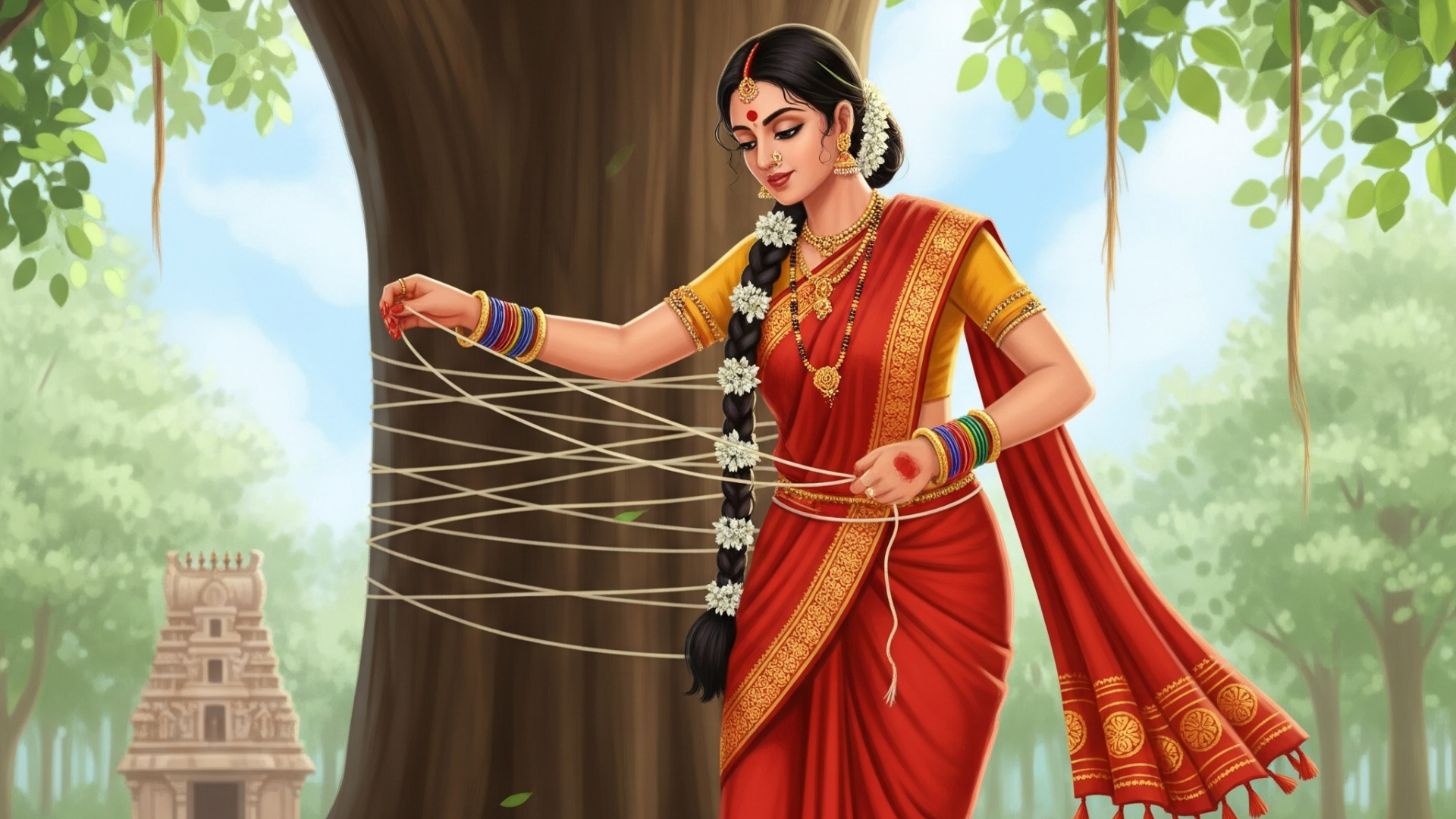
Vat Savitri Vrat holds immense importance for married women in Hinduism. This fast is observed especially by married women for the long life, well-being, and prosperity of their husbands and families. It is observed on the Amavasya (new moon day) of the Hindu month of Jyeshtha, which usually falls in May or June. In some regions, it is also celebrated on Jyeshtha Purnima (full moon day).
The name of this fast is derived from two sources — the Vat tree (Banyan tree) and Savitri, who is considered an ideal and devoted wife. The story of Savitri forms the basis of this vrat, where she brought her husband Satyavan back to life from the god of death, Yama, through her devotion, courage, and wisdom.
Why is Vat Savitri Vrat Observed?
This fast is observed in memory of Savitri’s unwavering devotion to her husband. Women draw inspiration from her and aspire to become like her — devoted, strong-willed, and righteous.
The primary objectives of this vrat are:
- To pray for the long life and health of the husband
- To maintain peace and harmony in married life
- To seek prosperity and progress for the family
- To evolve oneself as an ideal homemaker and woman
Significance of Vat Savitri Vrat
Vat Savitri Vrat holds great spiritual, cultural, familial, and environmental significance:
- Spiritual Significance:
This vrat symbolizes inner strength, devotion, and discipline. Like Savitri, a woman can overcome the greatest challenges through her courage and faith.
- Cultural Significance:
The vrat represents the powerful and devoted image of women in Indian culture. It reminds women of their responsibilities and inherent strength.
- Familial Significance:
The woman is considered the pillar of the family. Her health, devotion, and determination energize the entire household. This vrat promotes love and unity in the family.
- Environmental Significance:
Worshipping the Banyan tree holds ecological value too, as it is a life-giving tree, known for providing abundant oxygen and shade.
How to Perform Vat Savitri Vrat
- Sankalp (Vow):
Take a vow to observe the fast after bathing early in the morning and wearing clean, preferably red, clothes.
- Worship of Vat Tree:
Go to a Vat (Banyan) tree, pour water at its roots, apply turmeric, vermillion, roli, offer flowers and fruits.
- Tying the Sacred Thread:
Circumambulate the tree 7 or 108 times while tying a raw cotton thread (mouli) around its trunk. This represents the unbreakable bond between husband and wife.
- Reading the Vrat Katha:
Recite the Vat Savitri Vrat Katha (the story of Savitri and Satyavan) with devotion.
- Food and Charity:
After a day-long fast, consume fruits in the evening. Offer food and donations to Brahmins.
Benefits of Vat Savitri Vrat
- Blessings for husband’s long life and good health
- Peace and happiness in married life
- Blessing of offspring
- Increases inner strength and mental focus in women
- Ability to overcome difficulties in life
- Accumulation of spiritual merit (punya)
- Practices of purity, discipline, and devotion
- Enhances patience and self-control in women
The Story of Vat Savitri Vrat
In ancient times, there was a king named Ashwapati and his wife Malavti. After years of penance and devotion, they were blessed with a divine daughter named Savitri.
Savitri grew up to be beautiful, wise, and deeply virtuous. When she reached the age of marriage, she chose Satyavan, the son of King Dyumatsena, as her husband. Dyumatsena had lost his kingdom and was living in exile in the forest with his family.
When Savitri expressed her wish to marry Satyavan, the sage Narada warned her that Satyavan, though noble, was destined to die just one year after marriage.
Even after knowing this, Savitri didn’t change her decision and married Satyavan. She moved into the forest and wholeheartedly served her in-laws and husband.
One year later, on the destined day of Satyavan’s death, Savitri observed a strict fast and meditated under a Vat tree. Satyavan went to the forest to collect wood and Savitri accompanied him. In the afternoon, Satyavan suffered a severe headache and collapsed in Savitri’s lap. Soon, he passed away.
At that moment, Yamraj, the god of death, appeared and took Satyavan’s soul. Savitri followed Yama without hesitation.
Yama asked her to return, but impressed by her devotion and righteousness, he granted her boons. First, she asked for the eyesight of her blind in-laws to be restored. Second, she requested her father-in-law’s lost kingdom be returned. Yama granted both.
Then, she cleverly asked for a boon to become the mother of a hundred sons — something that would only be possible if her husband was alive. Realizing her intelligence and unwavering devotion, Yama granted her the final boon and returned Satyavan’s life.
This story conveys that a woman, with determination and faith, can overcome even death. Savitri’s strength, commitment, and wisdom made her immortal in Hindu tradition. Inspired by her, the Vat Savitri Vrat is observed.
Vat Savitri Vrat is not just a religious tradition but a symbol of feminine power, love, and devotion. It inspires women to develop inner strength, patience, and dedication to family. The values embodied by Savitri are as relevant today as they were in ancient times.
Through this vrat, one witnesses the grandeur, dignity, and idealism of Indian womanhood in the light of culture and spirituality.
















